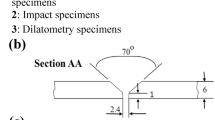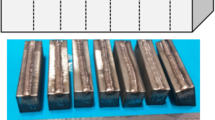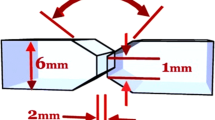Abstract
In this study, feasibility of using typical ferritic filler metals (409LNb, 430LNb, and 430Ti) for welding of low and medium chromium ferritic stainless steels (EN 1.4003 and types 409, 430, and 441) was investigated. The paper concentrates on basic mechanical properties of gas metal arc-welded joints at ambient temperatures. A variety of mechanical testing, i.e., tension, microhardness, macrohardness, impact toughness, and Erichsen cupping tests, were carried out in order to clarify differences between the joints fabricated with these filler metals. Further, effects of postweld heat treatments on toughness and ductility were evaluated. Microstructures of the welds were analyzed using optical and scanning electron microscopy. According to the results, the tensile strength and ductility are acceptable, but the major limiting factor with these, as with other ferritic filler metals, is poor impact toughness in the weld region. Welds fabricated with the 430LNb welding wire had a ductile-to-brittle transition temperature (DBTT) above ambient temperature. The titanium-stabilized filler metal 430Ti can have improved impact toughness due to grain refinement. The poor impact toughness in the weld region is not seen in the formability of the weldments in Erichsen testing. Postweld heat treatments are beneficial only when welding the traditional type 430 steel. In fact, unnecessary postweld heat treatment runs the risk of decreasing the weldment toughness owing to Laves-phase embrittlement, particularly with type 441.

















Similar content being viewed by others
References
Renaudot N, Santacreu PO, Ragot J, Moiron JL, Cozar R, Pédarré P and Bruyère A (2000) 430LNb—a new ferritic wire for automotive exhaust applications. SAE Technical Paper Series, 2000-01-0314
Honeycombe J, Gooch TG (1983) Corrosion and stress corrosion of arc welds in 18 % chromium–2 % molybdenum–titanium stabilised stainless steel. Br Corros J 18(1):25–34
Faivre L, Santacreu P-O, Leseux J (2011) Thermal fatigue resistance of welded joints in stainless steel high temperature exhaust applications. Tecnol Metal Mater 8(1):24–30
Inui K, Noda T, Shimizu T and Nagata M (2003) Development of the ferritic stainless steel welding wire providing fine grain microstructure weld metal for the components of automotive exhaust system. SAE Technical Paper Series, 2003-01-0979
Lippold JC, Kotecki DJ (2005) Welding metallurgy and weldability of stainless steels. Wiley, Hoboken, p 130
Ugitech Exhaust F1 Evolution 430LNbE—beyond 430LNb exhaust performance. Ugitech Technical Brochure (2009)
Sandvik 19.LNbTi welding wire datasheet. Sandvik Material Datasheet, S-23802-EN (2007)
Honeycombe J and Gooch TG (1982) Mechanical properties of arc welds in 18 % chromium 2 % molybdenum titanium stabilised ferritic stainless steel. TWI Technical Briefing
Madeira RP, Modenesi PJ (2008) The study of 430Ti and 430LNb ferritic welding wires for application in the cold part of automotive exhaust systems. Weld Int 24(6):412–421
Hunter GB, Eagar TW (1980) Ductility of stabilized ferritic stainless steel welds. Metall Trans A 11(2):213–218
EN ISO 14343: (2009) Welding consumables—wire electrodes, strip electrodes, wires and rods for fusion welding of stainless and heat resisting steels—classification
Panton-Kent R (1991) Phase balance in 9 %Cr1 %Mo steel welds. TWI Rep Bull(1)
Kaltenhauser RH (1971) Improving the engineering properties of ferritic stainless steels. Met Eng Q 11(2):41–47
Balmforth MC, Lippold JC (2000) A New ferritic–martensitic stainless steel constitution diagram. Weld Res Suppl Weld J 79(12):339–345
Franson IA and Fritz JD (1997) Stabilization requirements for T409 (UNS S40900) ferritic stainless steel. SAE Technical Paper Series, 971005
Mantel M, Baroux B, Gex D and Pedarré P (1990) The effect of niobium on the recrystallization of 17 % Cr ferritic stainless steel. Recrystallization ‘90, The Minerals, Metals & Materials Society
Castro R, de Cadenet JJ (1975) Welding metallurgy of stainless and heat-resisting steels. Cambridge University Press, Cambridge, p. 13 and p. 67
Kou S, Le Y (1982) The effect of quenching on the solidification structure and transformation behavior of stainless steel welds. Metall Mater Trans A 13(7):1141–1152
Villafuerte JC, Kerr HW, David SA (1995) Mechanisms of equiaxed grain formation in ferritic stainless steel gas tungsten arc welds. Mater Sci Eng, A 194(2):187–191
Nelson TW, Lippold JC, Mills MJ (1999) Nature and evolution of the fusion boundary in ferritic–austenitic dissimilar weld metals, part 1—nucleation and growth. Weld J 78(10):329–337
Kou S (2003) Welding metallurgy. Wiley, Hoboken, pp. 283–284
Bayraktar E, Katundi D, Yilbas BS, Claeys J (2011) Toughness of welded stainless steels sheets for automotive industry. J Achiev Mater Manuf Eng 44(1):35–41
Villafuerte JC, Pardo E, Kerr HW (1990) The effect of alloy composition and welding conditions on columnar-equiaxed transitions in ferritic stainless steel gas–tungsten arc welds. Metall Trans A 21(7):2009–2019
Perez de Oliveira M (2008) Nb in ferritic stainless steels. Technical Presentation, CBMM
Sello MP, Stumpf WE (2010) Laves phase embrittlement of the ferritic stainless steel type AISI 441. Mater Sci Eng, A 527(20):5194–5202
Juuti TJ, Karjalainen LP, Heikkinen E-P (2011) Precipitation of Si and its influence on mechanical properties of type 441 stainless steel. Adv Mater Res 409:690–695
Anbazhagan V, Nagalakshmi R (2002) Metallurgical studies in ferritic stainless steel welds. Weld Res J 23(3):25–37
Watanabe T, Shiroki M, Yanagisawa A, Sasaki T (2010) Improvement of mechanical properties of ferritic stainless steel weld metal by ultrasonic vibration. J Mater Process Technol 210(12):1646–1651
Acknowledgments
The current work has been carried out partly within a major European study concentrating on Structural Applications of Ferritic Stainless Steels (SAFSS). The research leading to these results has received funding from the European Community's Research Fund for Coal and Steel (RFCS) under Grant Agreement No. RFSR-CT-2010-00026. The authors acknowledge the financial support from Outokumpu Stainless Oy and the research support of Tornio Research Centre.
Author information
Authors and Affiliations
Corresponding author
Additional information
Doc. IIW-2350 recommended for publication by Commission IX "Behaviour of Metals Subjected to Welding".
Rights and permissions
About this article
Cite this article
Anttila, S., Karjalainen, P. & Lantto, S. Mechanical properties of ferritic stainless steel welds in using type 409 and 430 filler metals. Weld World 57, 335–347 (2013). https://doi.org/10.1007/s40194-013-0033-7
Received:
Accepted:
Published:
Issue Date:
DOI: https://doi.org/10.1007/s40194-013-0033-7




